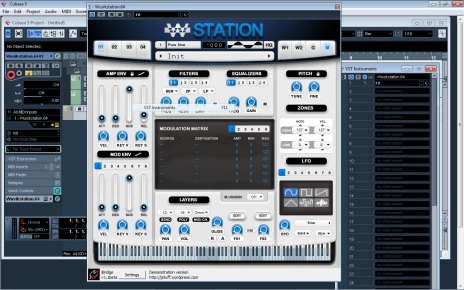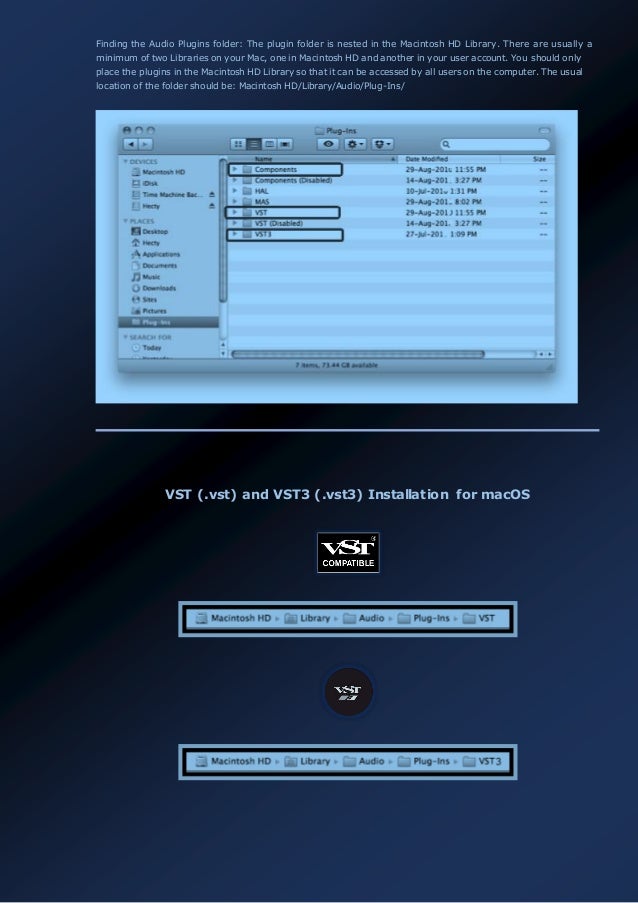What is Extreme Sample Converter?
Extreme Sample Converter is a multifunctional audio software, browser, player, and program editor with advanced conversion between different sample formats.
- Under 'Preferences', select the 'File Folder' menu. Click the 'Browse' button next to 'VST Plug-In Custom Folder'. Select the folder you would like Ableton to use for VST Plug-Ins. Confirm that the 'Use VST Plug-In Custom Folder' option is turned on, and the file path listed under 'VST Plug-In Custom Folder' leads to the folder you just selected.
- The VST plug-in files for the ARIA Player are named ARIA Player VSTx64.dll and ARIA Player VSTx86.dll for the 64-bit and 32-bit versions respectively. The steps for configuring VST plug-ins with a host program are entirely dependent upon the host. Please consult your host program's documentation for specific instructions.
Main Features:
Autoloop
Fx Vst Rack
Hardware Converter
Dual View
External Audio Editor
X-Fade Perfect Looping
Patch to Patch Conversions
* Factory Sound Banks, monolith HSB files, NKS files and derivative files are not supported. Audio File to Audio File Conversions
Patch to Audio File Conversions
Disc Import
| Professional Loop Editor
VSTi Converter
Real-Time Auditioning
Quick Editor
Virtual Image Support
Conversions between different formats
Browser and Viewer
Sound Files Browser
File Searching
|
Dmg Converter Vst Software Aolor DMG to ISO Converter for Mac v.1.0.0 Aolor DMG to ISO Converter for Mac is a super easy-to-use Mac disk utility that allows users to create Windows disk image ISO file from Mac disk image file DMG in only 3 steps: import DMG, set output directory and start the DMG to ISO conversion.
Demo limitations:
1. A short noise burst every few seconds added
Electronic Software Distribution (ESD) - you buy a license key, delivery is by e-mail.

Extreme Sample Converter for WINDOWS | |
40 EUR + VAT Extreme Sample Converter | |
This secure online registration service accepts all major credit cards: MasterCard, EuroCard, VISA, Delta, JCB, Switch, Solo, Discover, American Express, Diner's Club, UK cheque, US check, Eurocheque, Postcheque, International Money Order, Bank wire and PayPal. If paying by credit card, you can submit your card number by secure http-server, by fax, or by phone. Delivery is by e-mail. |
Registration Code is sent immediately after placing an order.
Make sure that e-mail you will give in order is correct.
When using the instrument as a plug-in, your MIDI and audio setup, including input devices, sample rate, and buffer size are all set by your host program.
When used as a plug-in, ARIA Player is not a standalone program but rather a virtual instrument player module that is integrated into a hostAudio or notation software that makes use of virtual instrument plug-ins. When the ARIA Player is used as a plug-in, your audio or notation software hosts it. application, such as your sequencerA computer program used for storing and transmitting sequences of musical information. Similar to a player piano that transcribes and plays musical information as holes in paper, MIDI sequencers use electronic data to record and reproduce performances. or notation softwareA computer program used for notating music. Common examples include MakeMusic Finale and Avid Sibelius.. One of the benefits to using the ARIA Player as a plug-in is the ability to open multiple instances of the ARIA Player at the same time, allowing for a total of more than 16 instrument slots. These are some of the various uses as a plug-in:
- MIDI recording and sequencing
- Audio mixing of software instrument tracks within a single program
- Automation of parameters in the host program
- Effect processing of instrument sounds using effects plug-ins
- Saving and recalling of all plug-in settings when the project is reloaded
- Integration with other instruments into a “virtual studio”
How To Use Dll Vst On Mac
The ARIA Player can be used as a VSTVirtual Studio Technology. A plug-in format developed by Steinberg that is supported in many audio programs and music software. Also VSTi to refer specifically to software instruments using the VST format. plug-in in many DAWDigital audio workstation. A DAW is a program that operates as a virtual studio for recording, editing, and playback. DAWs vary widely in their capabilities. Common examples include Steinberg Cubase, Apple Logic Pro, and Avid Pro Tools.s, sequencers, notation programs, and other hosts. The ARIA Player can also be used as an AUAudio Units. A plug-in format developed by Apple designed for OS X. Often used on Mac computers in place of VST plug-ins. plug-in on Mac or as an RTASReal Time AudioSuite. A plug-in format developed by Avid for use in their Pro Tools 10 and earlier software./AAXAvid Audio eXtension. A plug-in format developed by Avid for use in their Pro Tools 11 and later software. plug-in for Pro Tools. To use the ARIA Player as a plug-in instrument, launch your sequencer or notation program and load the ARIA Player from within it. Make sure that your host program is properly installed and configured, and that it is producing sound properly. Used as a plug-in, the ARIA Player’s audio and MIDI settings are managed by the host program. During installation, you choose which plug-in types to install on your computer.
| Plug-in Standard | Description | Windows | Mac |
| VST | The VST plug-in stands for Virtual Studio Technology and was developed by Steinberg, the makers of Cubase, Nuendo, and other audio programs. VST plug-ins are common to many audio programs. | X | X |
| Audio Units | The Audio Units (AU) plug-in standard was developed by Apple Inc. for Core Audio under Mac OS X and is used by Apple GarageBand, Apple Logic, and other Mac compatible audio programs. | Mac only | X |
| RTAS/AAX | RTAS plug-ins are designed to work with Avid Pro Tools 10 and several earlier versions. AAX plug-ins are designed to work Avid Pro Tools 11 and later. | X | X |
The ARIA Player is designed for any audio or music software that supports virtual instrument plug-ins. Each program has its own approach to installing, loading, and accessing plug-ins, so it is important to refer to the instructions in the host program’s user manual regarding plug-in support and handling. If you choose to include the VST plug-in during the ARIA Player installation, you are prompted to specify the location where you want to place it. The typical default location is C:Program Filesvstplugins or C:vstplugins. In this folder, there are two versions of the ARIA Player: ARIA Player VST_x86.dll, which contains a single stereo output, and ARIA Player Multi VST_x86.dll, which allows you to assign up to 16 stereo outputs. You may also see 64-bit versions of the plug-in here, ending in x64 rather than x86. You may need to direct your host application to this folder. Alternatively, you can copy the ARIA Player VST file to your host program's own VST folder. Please refer to your host program's user guide and the Garritan Knowledge Base for more information.
Some 64-bit hosts have one common VST folder for both 64-bit and 32-bit plug-ins; only use the version of the plug-in that is native to your host.
You can always find a copy of the ARIA Player VST in the C:Program FilesGarritanARIA PlayerVST folder also. However, we do not recommend using this folder as the main location for VST plug-ins on your computer, since uninstalling the ARIA Player removes this directory.
Set up plug-ins on Windows
Before you set up your plug-ins with your host program, ensure that you've installed them.
The VST plug-in files for the ARIA Player are named ARIA Player VST_x64.dll and ARIA Player VST_x86.dll for the 64-bit and 32-bit versions respectively.
The steps for configuring VST plug-ins with a host program are entirely dependent upon the host. Please consult your host program's documentation for specific instructions.
Typically, that set up process usually involves one of the following procedures:

- Copy the ARIA Player VST_x64.dll or the ARIA Player VST_x86.dll file to the folder that your host program scans for VST plug-ins.
If your host is a 32-bit program, copy the ARIA Player VST_x86.dll file to the host's plug-in folder. If it's 64-bit, copy the ARIA Player VST x64.dll file to the host's plug-in folder.
- Or, in the host program, specify the folder(s) that it should look in to find your VST plug-ins.
If you don't remember where you initially installed the VST plug-in files, you can find an extra copy in C:Program FilesGarritanARIA PlayerVST.
After completing either procedure, you may need to direct your host program to rescan your plug-ins folders.

If chosen upon installation, RTAS or AAX plug-ins are automatically installed into the correct location for your Pro Tools software.
Set up plug-ins on Mac
When you install the ARIA Player on Mac, all of the available plug-ins that you chose to install are automatically installed to the correct locations. On Mac, host programs use the same folders for VST or Audio Units plug-ins.
After installation, you may need to direct your host program to rescan your plug-ins folders. Please consult your host program's documentation for specific instructions.
Using the ARIA Player with a notation program
For more information about using the ARIA Player with notation programs, please refer to the instructions in your notation program’s user manual regarding the loading and operation of virtual instrument plug-ins. Some notation programs may not support virtual instrument plug-ins.
There are two ways to use ARIA Player with notation programs. One is to use it as a virtual instrument plug-in, as described above. The other is to use the ARIA Player standalone and route MIDI output from the notation application to the player. This is a more complex setup suggested only for advanced users.
VST Expression support
Some of the sample libraries available for ARIA support VST Expression, a new system that dramatically simplifies handling of articulations and expressions when using the sample libraryA piece of software consisting of a collection of recorded instrument sounds. Sample libraries can be used to play back existing MIDI sequences or to act as a live virtual instrument. within Steinberg Cubase. The new technology makes recording and editing articulation commands much easier, with all articulation data displayed separately in both track inspector and editor windows. More information about VST Expression can be found at the Steinberg website.
Leave feedback on this topic
ARIA Player User Manual
Copyright and trademarks

7007 Winchester Circle, Suite 140
Boulder, CO 80301
Leave feedback on this topic
ARIA Player User Manual
7007 Winchester Circle, Suite 140
Can Vst Work On Mac
Boulder, CO 80301